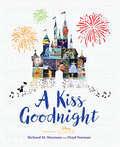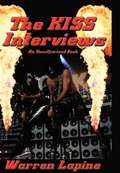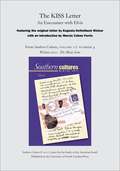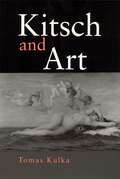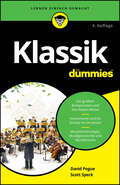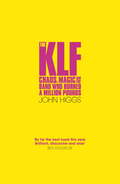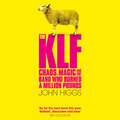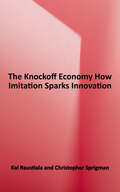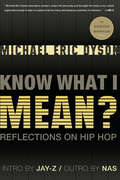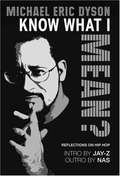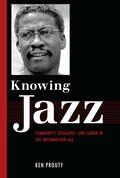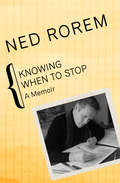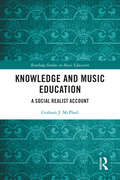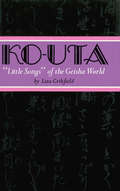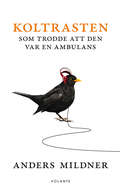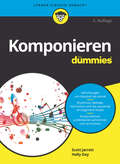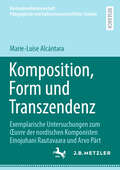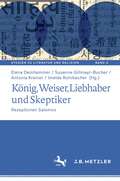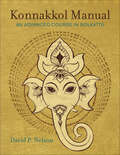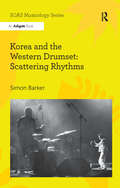- Table View
- List View
A Kiss Goodnight (Disney Editions Deluxe)
by Richard M. ShermanA beautifully illustrated storybook showcasing the lyrics to A Kiss Goodnight, written by Richard Sherman and heard every night at Walt Disney World and Disneyland during the fireworks shows.
The Kiss Interviews
by Warren LapineCollected here for the first time are sixteen interviews and articles with and about the hottest band in the world: KISS. Warren Lapine is an experienced interviewer and a long time KISS fan. This book is just what the doctor ordered for the hard core KISS fan. These interviews are insightful and intelligent, Lapine asks Paul Stanley and Gene Simmons the questions that KISS fans want to have answered.
The KISS Letter: An Encounter with Elvis
by Marcie Cohen FerrisThe last time I kissed him he only had on half a shirt. He has a wonderful chest. I am really crazy about him now+have the funniest feeling in me, all over."After she saw the King in concert and met him backstage, she wrote this letter to her friends at camp. Here's the original spicy note from the teenage girl who kissed--and kissed--Elvis Presley. This article appears in the 2011 Music issue of Southern Cultures.Southern Cultures is published quarterly (spring, summer, fall, winter) by the University of North Carolina Press. The journal is sponsored by the University of North Carolina at Chapel Hill's Center for the Study of the American South.
Kitsch and Art (G - Reference, Information and Interdisciplinary Subjects)
by Thomas KulkaWhat is kitsch? What is behind its appeal? More important, what is wrong with kitsch? Though central to our modern and postmodern culture, kitsch has not been seriously and comprehensively analyzed; its aesthetic worthlessness has been generally assumed but seldom explained. Kitsch and Art seeks to give this phenomenon its due by exploring the basis of artistic evaluation and aesthetic value judgments. Tomas Kulka examines kitsch in the visual arts, literature, music, and architecture. To distinguish kitsch from art, Kulka proposes that kitsch depicts instantly identifiable, emotionally charged objects or themes, but that it does not substantially enrich our associations relating to the depicted objects or themes. He then addresses the deceptive nature of kitsch by examining the makeup of its artistic and aesthetic worthlessness. Ultimately Kulka argues that the mass appeal of kitsch cannot be regarded as aesthetic appeal, but that its analysis can illuminate the nature of art appreciation.
Kitsch and Art
by Thomas KulkaWhat is kitsch? What is behind its appeal? More important, what is wrong with kitsch? Though central to our modern and postmodern culture, kitsch has not been seriously and comprehensively analyzed; its aesthetic worthlessness has been generally assumed but seldom explained. Kitsch and Art seeks to give this phenomenon its due by exploring the basis of artistic evaluation and aesthetic value judgments. Tomas Kulka examines kitsch in the visual arts, literature, music, and architecture. To distinguish kitsch from art, Kulka proposes that kitsch depicts instantly identifiable, emotionally charged objects or themes, but that it does not substantially enrich our associations relating to the depicted objects or themes. He then addresses the deceptive nature of kitsch by examining the makeup of its artistic and aesthetic worthlessness. Ultimately Kulka argues that the mass appeal of kitsch cannot be regarded as aesthetic appeal, but that its analysis can illuminate the nature of art appreciation.
Klang – Ton – Wort: akustische Dimensionen im Schaffen Marcel Beyers
by Sven Lüder Alice StaškováMarcel Beyer hat mit seinem vielfach ausgezeichneten Schaffen auf einzigartige Weise Grenzbereiche zwischen Literatur, Musik und Kulturtheorie erkundet. Sein Œuvre, das außer Romanen, Gedicht- und Essaybänden auch fünf Libretti umfasst, zeichnet sich durch eine spezifische Aufmerksamkeit für das Akustische aus, wobei Fragen der Darstellung, der Systematisierung und der Performanz stets mitbedacht werden. Auf vielfältige, bislang kaum angemessen ergründete Weise verschränken sich in seinem Schaffen Erfahrungen als Mitwirkender (Sprecher), als Autor von musikbezogenen Essays (v. a. Rezensionen) und als Co-Autor zumal im Musiktheater. Der Band, der auf ein 2019 in Jena veranstaltetes Symposium zurückgeht, enthält Beiträge, die in umfassend interdisziplinärer Weise die Dimensionen des Akustischen in Beyers Werken sowie Ausfaltungen des Dialogs zwischen Musik und Literatur, besonders auch in der Praxis des zeitgenössischen Musiktheaters, untersuchen.
Klassik für Dummies (Für Dummies)
by David Pogue Scott SpeckHier spielt der Spaß an der Musik die erste Geige! Sie möchten mehr über klassische Musik erfahren, wissen aber gar nicht, wo Sie anfangen sollen? Dann ist dieses Buch genau das richtige für Sie. David Pogue und Scott Speck zeigen Ihnen, wie spannend, aktuell und mitreißend klassische Musik sein kann. Sie bringen Ihnen unterhaltsam und informativ die Musikgeschichte vom Mittelalter bis heute nahe: die bedeutendsten Komponisten, ihre wichtigsten Stücke und viele lustige Anekdoten. Darüber hinaus erfahren Sie alles über die verschiedenen Instrumente und ihre Rolle im Orchester. Ein wenig nützliche Musiktheorie und ein kleiner Konzert-Knigge runden das Buch ab. Sie erfahren Wie Sie herausfinden, welche Musik Ihnen eigentlich gefällt Was es mit Sonaten, Sinfonien und Co. auf sich hat Wie Sie sich bestens auf ein klassisches Konzert vorbereiten
Klavier für Wiedereinsteiger für Dummies (Für Dummies)
by Mélanie RenaudHaben Sie vor längerer Zeit Klavierspielen gelernt und möchten nun Ihre Kenntnisse wieder auffrischen? Dieses Buch bietet Ihnen ein gut durchdachtes Programm für zwei Monate. Gewinnen Sie mithilfe von Fingerübungen, Technik-Etüden und ersten kleinen Musikstücken Ihre Fingerfertigkeit zurück. Trainieren Sie gezielt schwierige Passagen und lernen Sie ganz nebenbei ein wenig mehr über Musik. Begleitend zum Buch gibt es Videos der Übungen zum Download, sodass Sie nicht nur hören, wie die Musikstücke klingen sollen, sondern auch sehen, wie die Finger gesetzt werden müssen.
Klavierakkorde für Dummies (Für Dummies)
by Maxime Pawlak Renaud PawlakOb Klassik, Rock oder Pop, ob in der Band, im Orchester oder als Solist: Die Beherrschung der Akkorde ist beim Klavierspielen das A und O. "Pianoakkorde für Dummies" stellt Ihnen über 600 Akkorde vor und zeigt mithilfe von Fotos und Grafiken, wie Sie sie spielen. Die Autoren geben zu vielen auch hilfreiche Tipps. So können Sie selbst neue Varianten in Songs einbauen und einem schon häufig gehörten Lied neuen Schwung verleihen. In der Einleitung erfahren Sie, wie Akkorde aufgebaut sind und welche Spieltechniken es gibt. So werden Sie schon bald immer mehr Akkorde beherrschen.
The KLF: Chaos, Magic and the Band who Burned a Million Pounds
by John Higgs'By far the best book this year, brilliant, discursive and wise' BEN GOLDACRE. The strange tale of the death, life and legacy of the hugely successful band.They were the bestselling singles band in the world. They had awards, credibility, commercial success and creative freedom. Then they deleted their records, erased themselves from musical history and burnt their last million pounds in a boathouse on the Isle of Jura. And they couldn't say why.This is not just the story of The KLF. It is a book about Carl Jung, Alan Moore, Robert Anton Wilson, Ken Campbell, Dada, Situationism, Discordianism, magic, chaos, punk, rave, the alchemical symbolism of Doctor Who and the special power of the number 23.Wildly unauthorised and unlike any other music biography, THE KLF is a trawl through chaos on the trail of a beautiful, accidental mythology.
The KLF: Chaos, Magic and the Band who Burned a Million Pounds
by John HiggsThe strange tale of the death, life and legacy of the hugely successful band.They were the bestselling singles band in the world. They had awards, credibility, commercial success and creative freedom. Then they deleted their records, erased themselves from musical history and burnt their last million pounds in a boathouse on the Isle of Jura. And they couldn't say why.This is not just the story of The KLF. It is a book about Carl Jung, Alan Moore, Robert Anton Wilson, Ken Campbell, Dada, Situationism, Discordianism, magic, chaos, punk, rave, the alchemical symbolism of Doctor Who and the special power of the number 23.Wildly unauthorised and unlike any other music biography, THE KLF is a trawl through chaos on the trail of a beautiful, accidental mythology.Read by John Higgs(p) Orion Publishing Group 2018
The Knockoff Economy: How Imitation Sparks Innovation
by Kal Raustiala Christopher SprigmanFrom the shopping mall to the corner bistro, knockoffs are everywhere in today's marketplace. Conventional wisdom holds that copying kills creativity, and that laws that protect against copies are essential to innovation--and economic success. But are copyrights and patents always necessary? In The Knockoff Economy, Kal Raustiala and Christopher Sprigman provocatively argue that creativity can not only survive in the face of copying but can thrive. The Knockoff Economy approaches the question of incentives and innovation in a wholly new way--by exploring creative fields where copying is generally legal, such as fashion, food, and even professional football. <p><p>By uncovering these important but rarely studied industries, Raustiala and Sprigman reveal a nuanced and fascinating relationship between imitation and innovation. In some creative fields, copying is kept in check through informal industry norms enforced by private sanctions. In others, the freedom to copy actually promotes creativity. High fashion gave rise to the very term "knockoff," yet the freedom to imitate great designs only makes the fashion cycle run faster--and forces the fashion industry to be even more creative. Raustiala and Sprigman carry their analysis from food to font design to football plays to finance, examining how and why each of these vibrant industries remains innovative even when imitation is common. There is an important thread that ties all these instances together--successful creative industries can evolve to the point where they become inoculated against--and even profit from--a world of free and easy copying. And there are important lessons here for copyright-focused industries, like music and film, that have struggled as digital technologies have made copying increasingly widespread and difficult to stop. <p><p>Raustiala and Sprigman's arguments have been making headlines in The New Yorker, the New York Times, the Financial Times, the Boston Globe, Le Monde, and at the Freakonomics blog, where they are regular contributors. By looking where few had looked before--at markets that fall outside normal IP law--The Knockoff Economy opens up fascinating creative worlds. And it demonstrates that not only is a great deal of innovation possible without intellectual property, but that intellectual property's absence is sometimes better for innovation.
Know What I Mean?: Reflections on Hip-Hop
by Michael Eric DysonWhether along race, class, or generational lines, hip-hop music has been a source of controversy since the beats got too big and the voices too loud for the block parties that spawned them. America has condemned and commended this music and the culture that inspires it. Dubbed "the Hip-Hop Intellectual” by critics and fans for his pioneering explorations of rap music in the academy and beyond, Michael Eric Dyson tackles the most compelling and controversial dimensions of hip-hop culture. Know What I Mean? addresses the creative expression of degraded youth; the vexed gender relations that have made rap music a lightning rod for pundits; the commercial explosion that has made an art form a victim of its success; and the political elements that have been submerged in the most popular form of hip hops.
Know What I Mean? Reflections on Hip-hop
by Michael Eric DysonWhether along race, class or generational lines, hip-hop music has been a source of controversy since the beats got too big and the voices too loud for the block parties that spawned them. America has condemned and commended this music and the culture that inspires it. Dubbed "the Hip-Hop Intellectual" by critics and fans for his pioneering explorations of rap music in the academy and beyond, Michael Eric Dyson is uniquely situated to probe the most compelling and controversial dimensions of hip-hop culture. Know What I Mean?addresses salient issues within hip hop: the creative expression of degraded youth that has garnered them global exposure; the vexed gender relations that have made rap music a lightning rod for pundits; the commercial explosion that has made an art form a victim of its success; the political elements that have been submerged in the most popular form of hip hop; and the intellectual engagement with some of hip hop's most influential figures. In spite of changing trends, both in the music industry and among the intelligentsia, Dyson has always supported and interpreted this art that bloomed unwatered, and in many cases, unwanted from our inner cities. For those who wondered what all the fuss is about in hip hop, Dyson's bracing and brilliant book breaks it all down.
Knowing Jazz: Community, Pedagogy, and Canon in the Information Age (American Made Music Series)
by Ken ProutyKen Prouty argues that knowledge of jazz, or more to the point, claims to knowledge of jazz, are the prime movers in forming jazz's identity, its canon, and its community. Every jazz artist, critic, or fan understands jazz differently, based on each individual's unique experiences and insights. Through playing, listening, reading, and talking about jazz, both as a form of musical expression and as a marker of identity, each aficionado develops a personalized relationship to the larger jazz world. Through the increasingly important role of media, listeners also engage in the formation of different communities that not only transcend traditional boundaries of geography, but increasingly exist only in the virtual world. The relationships of "jazz people" within and between these communities is at the center of Knowing Jazz. Some groups, such as those in academia, reflect a clash of sensibilities between historical traditions. Others, particularly online communities, represent new and exciting avenues for everyday fans, whose involvement in jazz has often been ignored. Other communities seek to define themselves as expressions of national or global sensibility, pointing to the ever-changing nature of jazz's identity as an American art form in an international setting. What all these communities share, however, is an intimate, visceral link to the music and the artists who make it, brought to life through the medium of recording. Informed by an interdisciplinary approach and approaching the topic from a number of perspectives, Knowing Jazz charts a philosophical course in which many disparate perspectives and varied opinions on jazz can find common ground.
Knowing the Score: Film Composers Talk About the Art, Craft, Blood, Sweat, and Tears of Writing for Cinema
by David MorganThis collection of interviews with Hollywood composers offers the most intimate look ever at the process of writing music for the movies. From getting started in the business to recording the soundtrack, from choosing a musical style to collaborating with directors, including Martin Scorsese, Stanley Kubrick, the Coen brothers, Terry Gilliam, Kenneth Branagh, and Ken Russell, from learning to deal with editing to writing with time-sensitive precision, the leading practitioners in the field share their views on one of the most important -- and least understood -- aspects of filmmaking: the motion picture art that's heard but not seen.
Knowing When to Stop: A Memoir
by Ned RoremA thrilling, poignant, and bold memoir of the early years and accomplishments—both musical and sexual—of renowned contemporary composer Ned RoremNed Rorem, arguably the greatest composer of art songs that America has produced in more than a hundred years, is also revered as a diarist and essayist whose unexpurgated writings are at once enthralling, enlightening, and provocative. In Knowing When to Stop, one of the most creative American artists of our time offers readers a colorful narrative of his first twenty-seven years, expertly unraveling the intriguing conundrum of who he truly is and how he came to be that way. As the author himself writes, &“A memoir is not a diary. Diaries are written in the heat of battle, memoirs in the repose of retrospect.&” But careful thought and consideration have not dulled the sharp point of Rorem&’s pen as he writes openly of his life and loves, his missteps and triumphs, and offers frank and fascinating portraits of the luminaries in his circle: Aaron Copland, Truman Capote, Jean Cocteau, Martha Graham, Igor Stravinsky, Billie Holliday, Paul Bowles, and Alfred C. Kinsey, to name a few. The result is an early life story that is riveting, moving, and intimate—a magnificent self-portrait of one of the great minds of this age.
Knowledge and Music Education: A Social Realist Account (Routledge Studies in Music Education)
by Graham J. McPhailKnowledge and Music Education: A Social Realist Account explores current challenges for music education in relation to wider philosophical and political debates, and seeks to find a way forward for the field by rethinking the nature and value of epistemic knowledge in the wake of postmodern critiques. Focusing on secondary school music, and considering changes in approaches to teaching over time, this book seeks to understand the forces at play that enhance or undermine music’s contribution to a socially just curriculum for all. The author argues that the unique nature of disciplinary-derived knowledge provides students with essential cognitive development, and must be integrated with the turn to more inclusive, student-centred, and culturally responsive teaching. Connecting theoretical issues with concrete curriculum design, the book considers how we can give music students the benefits of specialised subject knowledge without returning to a traditional past.
Ko-Uta: Little Songs of the Geisha World
by Liza CrihfieldThis book of Japanese poetry and lyrics explores a little-known style of Japanese song called Ko-Uta.A Ko-Uta is translated as "little song" in Japanese. Unfamiliar to most Westerners, ko-uta are particularly in tune with the tradition of Japan's Edo-era merchants. Some ko-uta are aesthetic, many are earthy.Ko-uta are sung to the accompaniment of the shamisen-a traditional, three-stringed Japanese lute. Ko-uta come to life when they are sung, and the best example of where they live is in the geisha world. To help give some idea of the geisha world, this Japanese music book has provided a complete score of one song.Readers with some experience with haiku and other forms of Japanese poetry will find that ko-uta share many things with those forms. Yet, ko-uta retain their own unique interest, making this book a fascinating addition to any collection of Japanese literature or art.
Koltrasten som trodde att den var en ambulans
by Anders MildnerHur låter världen? Frågan kan tyckas märklig, det är väl bara att lyssna. Problemet är bara att vi aldrig varit särskilt duktiga på det, istället har vi i modern tid gjort precis allting för att slippa höra. Boken är en vindlande historia om spöken, militärens ljudvapen, koltrastar som tror att de är ambulanser, sjungande neandertalare, tyska filosofer, arkitektur, döva valar, klasskamp, den onde Kahn från Star Trek och laboratorieframställd popmusik. Med stor träffsäkerhet rör sig berättelsen mellan historia och populärkultur, mellan samhällsfenomen och den personliga reflektionen. Chansen är stor att boken bidrar till att du plötsligt hör sådant som du aldrig tänkt på och börjar förändra hur du arbetar och lever. Du kommer utan tvivel förstå hur vår ljudmiljö faktiskt är ett val som hänger nära ihop med hur vi förhåller oss till samhällsutvecklingen, och vilka som oftast blir vinnare respektive förlorare. Anders Mildner är journalist och författare. Han har bland annat jobbat på Sydsvenskan, Expressen och Svenska Dagbladet. I ett tidigare liv har han drivit musikbolag och spelat trummor i 90-talsbandet Beagle.
Komponieren für Dummies (Für Dummies)
by Scott Jarrett Holly DayVerwandeln Sie die kleine Melodie in Ihrem Kopf in eine große Inszenierung! Dieses Buch hilft Ihnen dabei, Ihre musikalischen Ideen umzusetzen, egal ob Klaviersonate, vielstimmiges Orchesterstück oder mitreißende Filmmusik. Lernen Sie das Komponieren beginnend bei den Grundzügen, mit Harmonien, Rhythmen, Tempi und Akkorden. Erfahren Sie, wie Sie Ihr Stück aufbauen, wie Sie für mehrere Stimmen komponieren und verschiedene Instrumente einsetzen, um große Gefühle mit Ihrer Musik zu übermitteln. Übung macht bekanntlich den Meister, darum unterstützt dieses Buch Sie mit vielen praktischen Aufgaben auf Ihrem Weg. Und wenn Sie Ihr Werk fertiggestellt haben? Auch hier wissen die erfahrenen Autoren zu helfen und beraten Sie mit vielen hilfreichen Tipps zu verschiedenen Karrieremöglichkeiten.
Komposition, Form und Transzendenz: Exemplarische Untersuchungen zum Œuvre der nordischen Komponisten Einojuhani Rautavaara und Arvo Pärt (Kirchenmusikwissenschaft. Pädagogische und kulturwissenschaftliche Studien)
by Marie-Luise AlcántaraDie vorliegende Untersuchung widmet sich der Fragestellung, inwieweit sich intendierte kompositorische Transzendenz in ausgewählten Werken des Finnen Einojuhani Rautavaara und des Esten Arvo Pärt anhand formaler Gestaltungsmittel äußert. Dabei ist von besonderem Interesse, inwiefern transzendentales, also jenseits des Gegenständlichen und Begrifflichen liegendes Musikerleben in Form gegossen wird, die als solche mit musiktheoretischer Terminologie konkret beschreibbar und in gewissem Sinne sogar objektivierbar wird. Die musikalische Form steht im Fokus der Betrachtung, da die Auseinandersetzung mit gerade diesem Parameter für beide Komponisten zeitlebens ein zentrales Thema ist bzw. war. In der Untersuchung wird zunächst der Begriff der (musikalischen) Transzendenz für sich stehend unter mehreren Aspekten beleuchtet. Hierauf fußend werden mittels musiktheoretischer Analyse Rückschlüsse auf kompositorische Verfahren bei Rautavaara und Pärt formuliert. Dafür werden ausgewählte Werke beider Komponisten unter dem Blickwinkel des Umgangs mit traditionellen Formen und Gattungen einerseits und des Schaffens innovativer Formprinzipien andererseits untersucht.
König, Weiser, Liebhaber und Skeptiker: Rezeptionen Salomos (Studien zu Literatur und Religion / Studies on Literature and Religion #4)
by Elena Deinhammer Susanne Gillmayr-Bucher Antonia Krainer Imelda RohrbacherKaum eine andere biblische Figur wird so enthusiastisch geschildert wie König Salomo. Er ist unvergleichlich weise, erbaut den Tempel in Jerusalem, und er verhilft auch seinem Volk zu einem Leben in Frieden und Wohlstand. Dennoch scheitert Salomo und erfüllt die in ihn gesetzten Erwartungen letztendlich nicht. Dadurch entsteht ein ambivalentes Bild, das innerhalb des biblischen Kanons und in der späteren Rezeptionsgeschichte vielfältig ausgestaltet wird. Wie facettenreich die Figur Salomos vom 16. bis 21. Jahrhundert in Literatur und Musik entfaltet wird, zeigt dieser Band auf. Die Beiträge im ersten Teil bieten überblicksartige Querschnitten, die Salomo als König, Weisen, Skeptiker und Liebenden in den künstlerischen Bearbeitungen präsentieren. Die Studien im zweiten Teil zeigen am Beispiel ausgewählter Werke, welche Diskurse der jeweiligen Zeit in der Figur König Salomos gespiegelt werden.
Konnakkol Manual: An Advanced Course in Solkattu
by David P. NelsonDavid Nelson wrote and compiled Konnakkol Manual to assist teaching an advanced course in the rhythmic compositions of Karnatak (South Indian) music. This new instructional book picks up where his previous book, Solkattu Manual, left off. It includes advanced exercises for developing control of odd pulse divisions, such as three and five notes per beat. There is a chapter on the sources of Karnatak tāas (meters), and another on the evolution of rhythmic compositions—told through the work of three generations of musicians. The main body of the book comprises full tani āvartanams (spoken percussion solos) in three tāas, together with instructions for practice, and Solkattu notation. Nelson created 150 instructional videos to accompany the text. They are accessible at www.weslpress.org/readers-companions/.
Korea and the Western Drumset: Scattering Rhythms (SOAS Musicology Series)
by Simon BarkerFor over a century, drummers have been turning to a variety of percussive traditions as prompts for the creation of new expressive possibilities on the drumset. In this book, Simon Barker sets out in detail the developmental processes he has followed creating an improvisational language for the drumset utilizing Korean rhythm/sticking cells, aesthetic conceptions, improvisatory codes, and developmental procedures. Barker offers historical overviews of Korean traditional rhythmic forms, analysis of rhythmic structures appearing in a variety of styles, an analysis and chronological account of his development of a 'Koreanized' approach to the drumset, a methodology for performing p’ansori accompaniment on the drumset, an introduction to Korean extended techniques, and a large collection of drumset studies based on Korean traditional forms such as tasÅrÅm, ch’ilch’ae, and ritual music structures from Korea’s East Coast. Barker also explores physical practices employed by Korean musicians which aid in the development of a relaxed, dynamic approach to performance. He creates a framework for creating an alternative approach to drumset education and performance through an engagement with Korea’s extraordinary rhythmic and aesthetic traditions. The volume includes an accompanying CD featuring recordings of developmental exercises, solo drumset improvisations, and ensemble performances, each track representing a subject of discussion within the volume.
